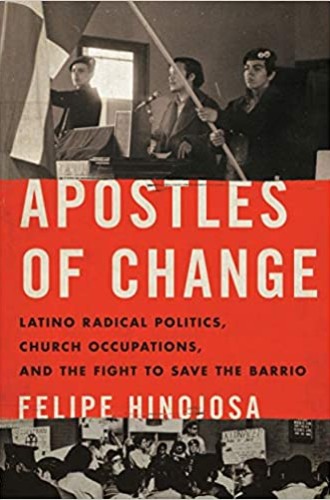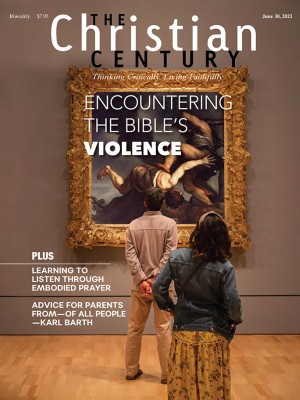When radical Latino activists occupied churches
Felipe Hinojosa profiles resistance movements from the late 1960s and early 1970s, when religion and politics were inextricably linked.
We remember the 1960s and early 1970s as a time of rapid social change, unbounded optimism, and passionate activism. But some stories from that time are in danger of being forgotten. In this comprehensive but concise study, historian Felipe Hinojosa zooms in on radical, Latina/o political and social movements in four major US cities that included occupations of churches between 1969 and 1970.
These activists were inspired by Latin American liberation theology to resist racism, the intentional displacement of city dwellers living in poverty, police brutality, and other injustices. “Seeing these young radicals serve breakfast inside the church, cite Bible verses, and proclaim that the church belongs to the people,” writes Hinojosa in the book’s introduction, “shocked and motivated religious leaders to take action at some of the most iconic and historic institutions in the country: the Methodist, Presbyterian, and Catholic churches.”
Read our latest issue or browse back issues.
Through his profiles of resistance movements in Chicago, Los Angeles, New York, and Houston, Hinojosa seeks to show that religion and politics were inextricably linked:
As much as Latina/o radicals chastised the church as an oppressive institution, they remained open to working and collaborating with religious leaders. . . . Their spirituality broke down institutions, recognized the power of the community, and believed in the shared religious authority of clergy and laypeople alike. A spirituality has always existed outside of the realm of the institutional church that is pragmatic and focused on this world, rather than the one to come.
Hinojosa’s narrative begins in Chicago’s Lincoln Park neighborhood, where in 1969 a Latina/o organization called the Young Lords occupied McCormick Theological Seminary, a Presbyterian school which has since moved to the Hyde Park neighborhood. The Young Lords movement began in the 1950s and 1960s, as so-called urban renewal programs raised rents and made it impossible for low-income people—most of whom were Latina/o or African American—to remain in the neighborhoods where they had lived for years. “Chicago was a world made by displacement,” Hinojosa states.
The Young Lords sought to organize their communities and resist this displacement, often collaborating with religious leaders. On May 14, 1969, they occupied McCormick’s administration building to protest the institution’s support for the city’s structurally racist urban renewal policies that led to the displacement of people. They presented the United Presbyterian Church in the United States of America, a predecessor of today’s Presbyterian Church (USA), with a list of demands including low-income housing, a day care center, and a Puerto Rican cultural center. While these demands were not met, the occupation was significant in that it revealed Latina/o activists and religious leaders as a force to be reckoned with and called upon the church to live up to its mission.
A similar movement occurred around the same time in Los Angeles among Roman Catholics. Inspired by the Young Lords, a group called Católicos por La Raza began protesting the newly constructed St. Basil’s Church, “whose opulence and $3 million price tag represented the latest scandal for a Catholic Church that seemed out of touch with its largest constituency in Los Angeles—Mexican Americans.” Inspired by Vatican II and Latin American liberation theology, Católicos criticized ultraconservative archbishop James Francis McIntyre and demanded a new focus on the concerns of those in poverty. Their demands included church-based housing support, shared governance within the church, and an end to fees for parochial schools.
These demands went unmet, and ultimately the activists disrupted the 1969 Christmas Eve mass at St. Basil’s. This action and the movement it represented were significant in showing the power of laity in the post-Vatican II Catholic Church and the important links between the church and the Chicano Movement. As Hinojosa explains, “the visuals of young people carrying placards that read ‘Jesus did not drive a Cadillac’ or ‘Chicanos are God’s children too’ brought the frustrations out into the public arena—into secular spaces—and in the process brought Chicana/o movement politics into the sacred spaces of the church.”
The chapter on New York City focuses on the Young Lords’ takeover of the First Spanish United Methodist Church, which occurred in 1969 as a response to the cancellation of social service programs that the group was running at the church. Grounded in the Puerto Rican community, the New York Young Lords were very much in contact with the Chicago chapter, as well as aware of the struggles for justice within Latin America. According to Hinojosa, “occupying the church was a way to reclaim not solely an institution but an experience that they recognized as theirs, an understanding of the sacred—a political spirituality—organic to them and their experiences living in East Harlem, Brooklyn and the Bronx.” Their movement led to the founding of the now famous Nuyorican Poets Cafe and other Puerto Rican organizations that have endured to this day.
Hinojosa’s final case study is especially interesting, as Houston is both a western city and a southern one, with the legacy of racism and Jim Crow deeply ingrained in its culture. It is also a sprawling metropolis that, in the middle of the 20th century, invested in its suburbs at the expense of its urban core. In the spring of 1970, members of the Mexican American Youth Organization occupied the Juan Marcos Presbyterian Church after its pastor denied them the use of the building for community programs. Even though the pastor believed in the group’s missions, he wanted to keep “strict boundaries between ‘insiders’ and ‘outsiders,’ a common practice in working-class churches like Juan Marcos.” The group reacted by occupying the church to show that “the church belonged to the people.”
Throughout these four portraits, Hinojosa does an excellent job of showing the importance of religious spaces to Latina/o justice movements in the late 1960s and early 1970s—a reality that has often been overlooked by historians. Rather than focusing on clergy, Hinojosa focuses on the laity. The Catholic writer Rhonda Miska has drawn a distinction between the “upstairs church” of religious services and the “downstairs church” of community activities that occur once the service is concluded. Hinojosa’s study reaffirms the importance of religious spaces for social change and community flourishing.
Another important contribution of Apostles of Change is that it reminds readers of Christianity’s progressive tradition in the United States. Ever since Jerry Falwell, in the words of biographer Michael Sean Winters, “made God a Republican and baptized the American right,” US Christianity has so often been associated with political conservatism in the public imagination. Hinojosa reminds us that just as the church was a primary impetus for the African American civil rights movement of the 1960s, it was also an important space of resistance in Latina/o justice movements—and it continues in that role to this day.
Though accessible to a general audience, this is an academic text that requires concentration to take in its nuances; it is definitely not a beach read. However, it is important for anyone interested in social movements, Latina/o history, and urban studies. The case studies also offer wisdom that community workers and activists might draw on for their work. In words that recall Dorothy Day’s call for a “revolution of the heart,” Hinojosa argues that there is much we can learn from the idealism of these activists from half a century ago. “Love and imagination drive revolution. Rage is only bitterness if it is not fueled by a deep and abiding love,” says Hinojosa. This is a critical message for our time.






